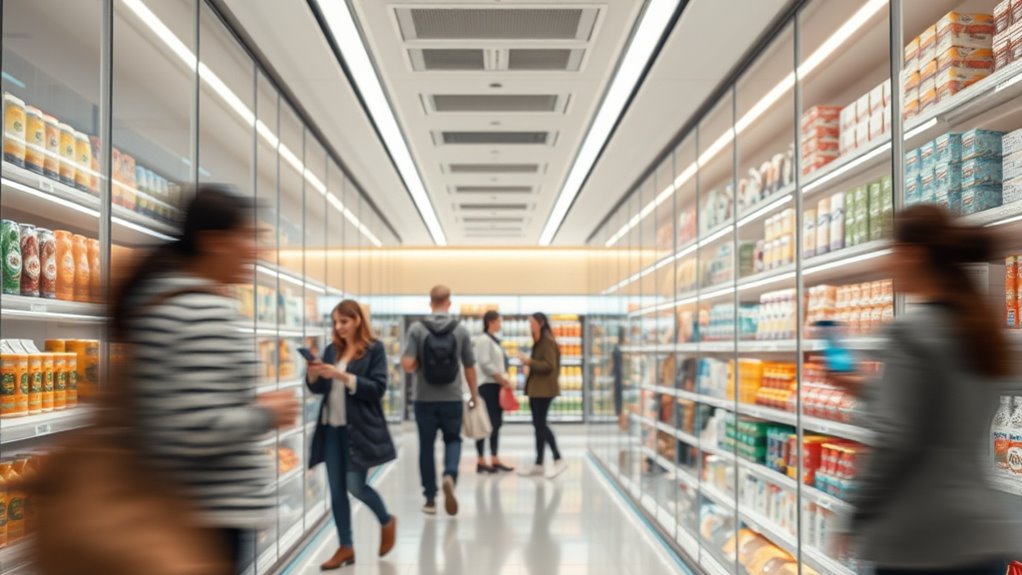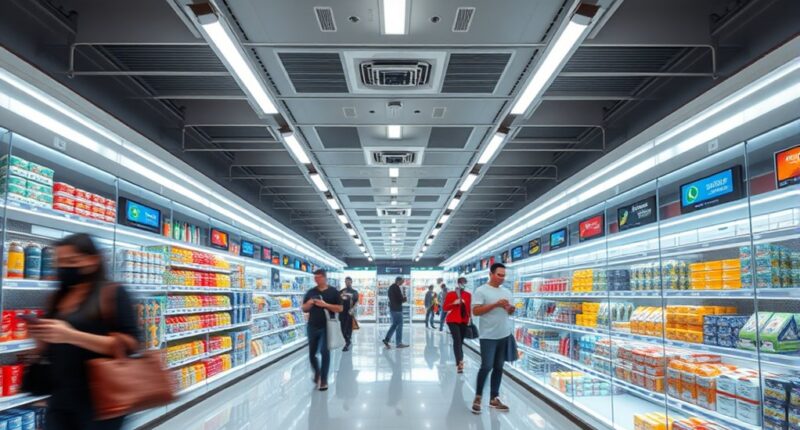Autonomous retail stores are transforming shopping by using AI, IoT, and sensors that track your purchases in real time, eliminating checkout lines. These stores adapt layouts with digital heatmaps and provide personalized recommendations through virtual assistants. Inventory is managed precisely, reducing stockouts and waste. Automation cuts costs and streamlines operations, making shopping faster and more efficient. Continuing to explore will reveal how these innovations are shaping the future of retail experiences.
Key Takeaways
- Autonomous retail uses AI, IoT, and sensors to track purchases and charge customers automatically.
- Digital heatmaps and analytics optimize store layouts and customer flow for efficiency.
- AI-powered inventory management maintains high accuracy, reducing stockouts and wastage.
- Automated checkout solutions significantly cut processing times, enhancing customer experience.
- These stores support omnichannel strategies, providing seamless online and in-store shopping.

Autonomous retail and checkout-free stores are transforming the way you shop by leveraging cutting-edge technology to create seamless, frictionless experiences. As you walk into these stores, you’re greeted by a blend of AI, IoT, and hyperconnectivity working behind the scenes to make your shopping quick and effortless. Instead of waiting in lines or fumbling with cash or cards, your purchases are tracked automatically through sensors and AI-powered systems, allowing you to simply pick up what you need and leave. The store’s technology detects your presence, logs your selections, and charges your account instantly, making the entire process smooth and efficient. Real-time data plays a crucial role in optimizing these systems, ensuring accurate and timely updates for both retailers and shoppers.
Seamless shopping with AI and sensors, allowing quick, effortless checkout without lines.
This integration of digital tools enhances personalization, too. Virtual assistants powered by AI analyze your shopping habits and preferences, offering tailored product recommendations before you even ask. Stores leverage consumer behavior, social signals, and real-time data to optimize product placement and marketing content, ensuring you find what you want faster and more intuitively. AI-driven inventory tracking and dynamic content creation help stores stay stocked with the right products, reducing out-of-stock issues and excess inventory. Retailers use demand forecasting models to predict what shoppers will want, adjusting stock levels accordingly. In 2024, up to 60% of retailers report benefits from these AI-powered inventory and demand management systems, leading to fewer missed sales and improved cash flow.
Automation doesn’t just improve your experience—it also boosts operational efficiency for store owners. Without the need for human staff, autonomous stores cut labor costs markedly, increasing profitability. Automated checkout solutions, like those at JuiceBabe, have slashed bill processing times by around 80%, making checkout lines a thing of the past. Better inventory accuracy, reaching up to 99%, minimizes stock discrepancies and wastage. This precise inventory management, supported by real-time sales data, prevents costly overstocking or stockouts. By accurately predicting demand, stores can optimize restocking schedules, ultimately reducing revenue losses associated with out-of-stock situations, which in North America alone caused over $349 billion in 2022.
Your shopping experience is also improved through data-driven insights. Digital heatmaps and behavioral analytics help store layouts adapt to how customers move and interact, making shopping more engaging and efficient. AI virtual assistants can recommend products tailored to your preferences, making your visit feel personalized and relevant. These stores support omnichannel strategies, providing a unified shopping journey whether you’re browsing online or in person, boosting customer satisfaction and loyalty. The growth of AI and automation is expected to accelerate further, fundamentally reshaping retail operations and customer expectations in the coming years.
Frequently Asked Questions
How Secure Are Customer Payment Methods in Checkout-Free Stores?
You might wonder how secure your payment methods are in checkout-free stores. While these stores use advanced tech like machine vision and integrated security cameras, many lack strong authentication, which can pose risks. Your trust depends on the store’s security interface and verification steps. If they don’t verify your identity properly, you could face fraud or data breaches. Ensuring secure, well-designed payment systems helps protect your data and builds confidence.
What Are the Environmental Impacts of Autonomous Retail Stores?
When it comes to environmental impacts, autonomous retail stores are a double-edged sword. You’ll find they consume less energy through automation and energy-efficient tech, cutting emissions. They also reduce waste with smarter inventory management. However, the high-tech infrastructure and data centers can increase electronic waste and energy use. So, while they’re a step in the right direction, you should keep an eye on their long-term sustainability efforts.
How Do Stores Handle Product Replenishment Automatically?
You see, stores handle product replenishment automatically by using sensors, cameras, and AI to monitor stock levels in real-time. These systems analyze data and forecast demand, then generate reorder suggestions or orders. Robots and automated workflows move stock from storage to shelves efficiently, while integrated software coordinates restocking, reducing human effort and errors. This seamless process keeps shelves stocked, ensuring your shopping experience remains smooth and uninterrupted.
What Privacy Concerns Arise With Data Collection in These Stores?
Imagine walking into a store where every move you make is watched like a hawk. You might worry about your privacy as cameras, sensors, and AI track your behaviors and collect biometric data. This data can be misused or shared without your consent, risking breaches and legal issues. You also face concerns about transparency and whether your rights to control your information are respected, making trust in the store shaky.
How Do Autonomous Retail Stores Adapt to Different Store Layouts?
You see, autonomous retail stores adapt to different layouts by customizing sensor placement and AI algorithms. For grid layouts, you optimize narrow aisles for inventory tracking; for loop designs, you focus on monitoring customer flow and impulse zones; and for free-flow setups, you use wide-area sensors to track flexible movement. This tailored approach guarantees smooth operations and enhances customer experiences, regardless of the store’s design.
Conclusion
As you step into this new era of shopping, autonomous retail and checkout-free stores transform the way you shop forever. With technology so advanced, it’s like having a retail revolution in the palm of your hand—faster, smarter, and more seamless than you ever imagined. Get ready to experience the future today, where waiting in lines becomes a relic of the past and shopping is an adventure you control. The retail world will never be the same!









